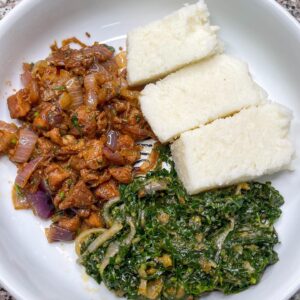Table of Contents

What is Ugali?
Countries That Eat Ugali
Ugali is a rich porridge and an important part of the East African indigenous people’s diet. In Kenya, this prevalent staple dish, ugali, or nsima, is typically served with a vegetable and/or meat stew. Other names it is known for include; sadza, nsima, or posho.
Ugali, arguably Africa’s most popular food, is consumed in Nigeria, Uganda, Kenya, Botswana, Tanzania, and the Democratic Republic of the Congo. Although cornmeal is the most common flour used, other flours such as millet and sorghum are also used.
In most households generally in West Africa, ugali is the main course, with vegetables or meat as side dishes. It is eaten with an abundance of flavorful vegetables and meats in a spicy gravy in wealthy houses or for special occasions. It’s also similar to the mashed potatoes that are commonly offered in American households.
What Does Ugali Taste Like?
Ugali has a fairly mild taste on its own. The maize gives it a subtly sweet, grainy flavor. But it’s also quite bland without added flavors. The texture is where ugali really shines – it’s thick and doughy with a starchy, sticky consistency.
Varieties of Ugali
Known as Ugali in Kenya and Tanzania, this starchy, polenta-like side dish goes by different names in sub-Saharan Africa. In Malawi and Zambia, it is called Nsima or Nshima. The South African name for it is pap or mealie pap. Zimbabweans call it sadza.
It is usually served as an accompaniment to meat or vegetable stews, greens, or soured milk. To eat it, pull off a small ball of mush with your fingers. Form an indentation with your thumb, and use it to scoop up accompanying stews and other dishes.
Or you can form larger balls with your hands or an ice cream scoop, place them in individual serving bowls, and spoon stew around them.

Ugali Recipe
Made from maize flour which has been cooked with water until reaching a consistency similar to that of dough, the ugali is the most common staple food in the region.
It is traditionally eaten with the hands. Like flat bread in other countries, ugali can be used as a sort of ‘scoop’ to pick up meat and vegetables. When it is not dipped in a stew, it is dipped in a sauce.
How Long Does Ugali Take to Cook
Boil water, after boiling add the maize flour as you do with regular ugali. After adding the unga stir the ugali flour until it is firm. Cover and allow to steam for 10 minutes.
Is Ugali Similar to Fufu?
Yes, ugali is quite similar to fufu. Both are thick porridges or doughs made from starchy ingredients, while ugali is made from maize flour, fufu is made from cassava flour. Ugali originated in East Africa while fufu is more common in West Africa.
But they’re prepared and eaten in a comparable way – often rolled into balls and dipped into stews or sauces. Facts About Preparing This Dish
- White cornmeal is the most commonly used grain for this recipe.
- But you can substitute sorghum, millet or coarse cassava flour, or even hominy grits.
- More or less water can be added to achieve the consistency you prefer.
- Most Africans would not salt the water, so you can leave the salt out if you wish.
- Stir in a little butter for a richer flavor.
Below is the step-by-step recipe on how to make this easy recipe. If you make it don’t forget to leave a comment. Enjoy!

Ugali
Ingredients
- 4 cups Water
- 1 tsp Salt
- 2 cups White cornmeal finely ground
Instructions
- Bring the water and salt to a boil in a heavy-bottomed saucepan.
- Stir in the cornmeal slowly, letting it fall through the fingers of your hand.
- Reduce heat to medium-low and continue stirring regularly, smashing any lumps with a spoon, until the mush pulls away from the sides of the pot and becomes very thick, about 10 minutes.
- Remove from heat and allow to cool somewhat.
- Place the Ugali into a large serving bowl.
- Wet your hands with water, form into a ball, and serve.

